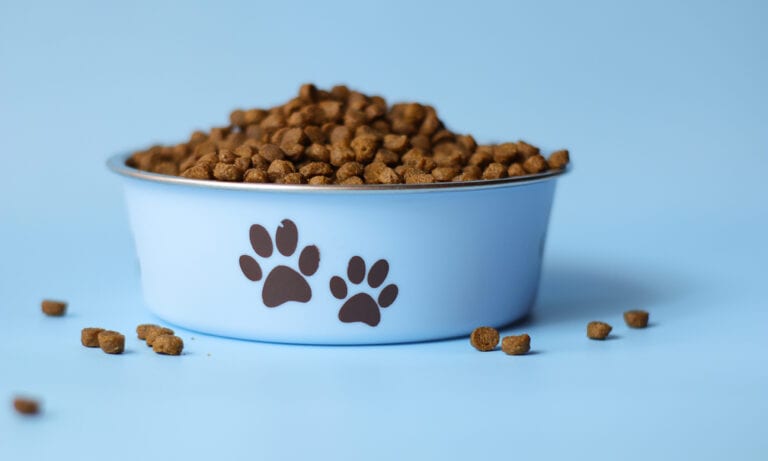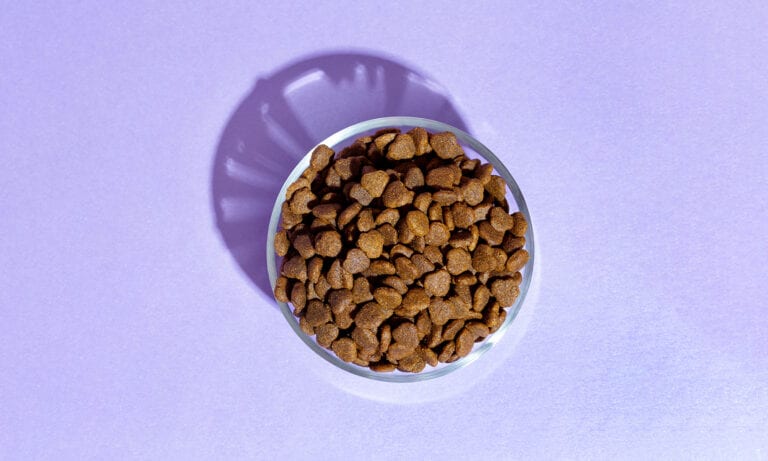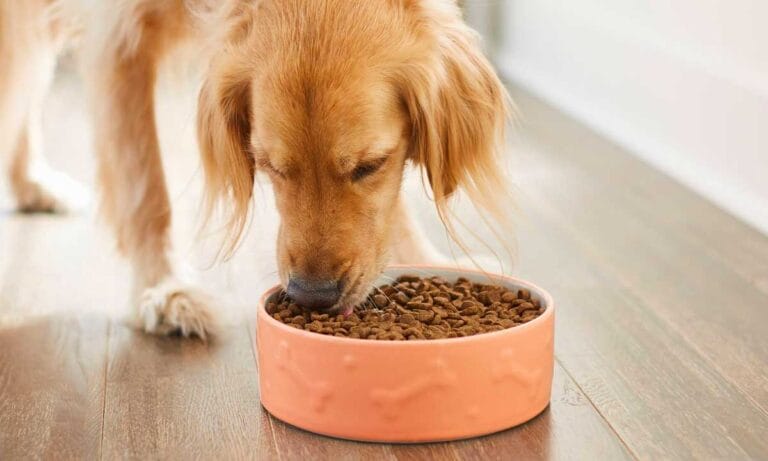When shopping for your pup’s food, have you ever read the label and thought, “What does that mean?” With so many terms and phrases on dog food labels, like “complete and balanced,” “natural” and “meat byproducts,” it can be downright confusing to differentiate between marketing buzzwords and key information.
We spoke with veterinary experts to help decipher what each common term and phrase on a dog food label means. That way, you’ll know exactly what’s in different pet foods and can pick the best one for your doggie (with your vet’s help, too, of course).
In This Guide:
What’s on a Dog Food Label?


A dog food label is filled with all the information needed to determine if it’s the perfect choice for your pooch. This information includes:

1Product and Brand Name
2Intended Species
3Net Weight or Net Volume

4Guaranteed Analysis
5Ingredients List
Just like with human food labels, you’ll find every ingredient the dog food contains on the ingredients list. All food ingredients are listed in descending order by weight, providing insight into the quantity and types of ingredients, Dr. Kong says.
The first ingredient should always be the protein source; followed by carbohydrates, fats and fiber; and vitamins and minerals, says Dr. Ray Spragley, DVM, CVA, CCRT, owner and founder of Zen Dog Veterinary Care in Tuckahoe, New York. Some common sources of protein in dog food are chicken, lamb and beef. In plant-based dog foods, common protein sources are corn gluten meal and soybean meal.
A few ingredients Dr. Spragley recommends avoiding include:
- BHA (butylated hydroxyanisole)
- White flour
- Artificial food coloring
- Corn syrup
- Nitrates
6Calorie Content
7Feeding Guidelines
The feeding directions on a dog food label come in handy when trying to determine how much food to feed your dog (as opposed to how much they want you to feed them!). These are general suggestions based on dogs with average activity levels and on a dog’s weight and lifestage. You can always consult with a vet to learn exactly how much your pooch should be eating based on their individual needs.
The resting energy requirement (RER) formula is used to estimate a dog’s daily calorie needs by using the dog’s weight in kilograms raised to the ¾ power, then multiplied by 70, Dr. Kong explains.
Below is a rough estimate of the daily calories required for dogs of different weights:
5
2.3
200
10
4.5
300
15
6.8
400
20
9.1
475
30
13.6
600
40
18.1
800
50
22.7
900
60
27.2
1,100
70
31.8
1,200
80
36.3
1,350
90
40.9
1,500
100+
45.4
1,600+
8Nutritional Adequacy Statement
9Manufacturer
10Best By or Expiration Date
Terms to Know on Dog Food Labels
AAFCO
The Association of American Feed Control Officials (AAFCO) recognizes food for different nutrient profiles: puppies and pregnant and nursing pets; adult maintenance; growth (includes puppies); and all life stages, Dr. Spragley says. When shopping for high-quality dog food, look for the nutritional adequacy statement (typically on the back or side of the label) to ensure it contains all essential nutrients your canine companion needs.
Ash
Seeing “ash” on a dog food label can be puzzling. Not to fear! The ash level simply refers to the amount of minerals in pet food, such as calcium, iron, copper, phosphorus, zinc, etc. Dr. Spragley says it’s more affordable to measure ash rather than the individual minerals; this is measured by burning the feed, which burns off all organic materials like fat, protein, fiber and vitamins, and leaves only the minerals remaining.
Byproducts
One question many pet parents may have when reading a label is, “What are byproducts in dog food, exactly?”
Byproducts in dog food are typically ingredients left over from human food production after it’s been processed. This can include trimmings, kidneys, liver, spleen and lungs, Dr. Spragley says.
Crude protein
Crude protein is the gold standard of protein in dog foods, Dr. Spragley says. Crude proteins are protein molecules divided into small units, aka peptides, and are easier for dogs to convert into individual amino acids. Dogs require different levels of crude protein based on their life stage and activity levels.
Human-grade
If you see “human-grade” on a label, Dr. Spragley says, this means the dog food abides by the Food and Drug Administration (FDA) and often the United States Department of Agriculture’s (USDA) safety and quality standards for human food. This also applies to how and where the food is prepared.
Meal
The terms “poultry meal,” “beef meal,” “lamb meal” and meat byproduct meal are commonly seen in dog food. But what is meal in dog food?
This means protein in byproduct meal is derived from parts of animals that aren’t typically sold for human consumption. These parts are then rendered into a protein powder and include residual meat, connective tissues, internal organs and bones. Meat meal is a more cost-effective alternative to serving fresh meats.
Natural
“‘Natural’ on a dog food label means the pet food has been made without added artificial colors, flavors or preservatives,” Dr. Spragley says. “The ingredients can only come from plants, animals or minerals.”
Organic
Much like organic human food, an “organic” seal on pet food indicates the food meets the USDA’s National Organic Program (NOP) production and handling requirements, and contains at least 95 percent organic ingredients.
How Is Pet Food Labeling Regulated?
The AAFCO provides guidelines as to how dog food (and cat food!) should be labeled, Dr. Spragley says. “AAFCO does not have direct regulatory authority but is made up of officials from government agencies, which have direct control over regulations,” he says.
The AAFCO requires the following on pet food product labels:
- Product and brand name
- Intended species
- Net quantity statement
- Guaranteed analysis
- Ingredient statement
- Nutritional adequacy statement
- Feeding directions (if needed)
- Manufacturer’s name
MORE ON DOG FOOD:
Share:











